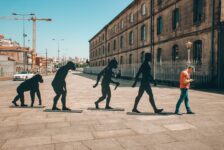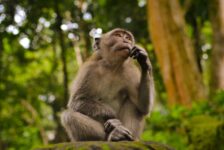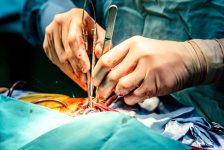Mention bacteria and viruses to most people and the response is to recoil in fear. A catalog of bacterial, viral and fungal infections tend to dominate our discussions about the microbial world, and has done so ever since we discovered the role of microbes in disease. Pandemics like the Black Death which killed some 30-60% of Europe’s total population, the scourge of smallpox which is estimated to have killed 300 million in the 19th century are lodged in our memories, whilst the Spanish flu in 1918 is credited with the deaths of 20-50 million between January 1918 and December 1920. More recent brushes with pathogens like HIV, SARS, Ebola, Marburg virus, MERS, Hantavirus, and so many others serve to further increase our fear of microbes in general. But things have fundamentally changed in the past decade, we have discovered that the evolution of our species is inextricably linked with the microbial world.
When the Human Genome Project was completed in 2003, there were a few surprises in store; we discovered that our genome is littered with a myriad of genetic fossils that reveal our complex relationship with microbes. About 8% of our genome was found to contain remnants of ancient viral infections known as endogenous retroviruses. A retrovirus replicates by inserting its DNA into a host cell. In some instances, a retrovirus infects germ line cells found in sperm and eggs, and if the infected cells survive to create a new organism, then the retrovirus, by hitching a ride, will be passed on to the next generation.
Most of these genomic fossils are inactive and unable to produce infectious particles, but it seems some of these ERVs have been co-opted to perform new functions within the host organism. ERVs in humans are called HERVs, and one group of these (HERV-K) appears to be still capable of replication. Another group of these ancient viral elements (HERV-H) was recently found not only still active but was crucial in allowing a fertilized human egg to grow into an embryo. Some of these viral elements are uniquely shared by primates and serve as compelling evidence of common ancestry.
In 2000, a team of Boston scientists discovered a curious gene in the human genome that encodes a protein made only by placental cells. The syncytin gene, as it was later called, makes the protein that fuses together the placenta and uterus to create a single layer called the syncytiotrophoblast, which is crucial for a fetus taking nutrients from its mother. Without syncytin, the placenta and uterus cannot fuse together. But what was even more curious is that the syncytin gene is not a human gene, it is a viral gene.
At least 100,000 known snippets of viruses are now known to reside in our genome, but syncytin was found not to be unique to humans. Chimpanzees, gorillas, and monkeys share this ancient viral gene with humans and at the same spot in their genome. Later research revealed that shutting down the syncytin gene in mammals led to the death of the embryo at 11 days as it could not form a syncytiotrophoblast, so clearly, this viral gene is crucial to the development of the embryo.
Another ERV known as MER41 is also known to play a vital role in our immune system; humans have about 7,000 copies of it. One copy of the MER41 virus sits next to a gene called AIM2. AIM2 detects when human cells have been infected by certain viruses and bacteria, and forces the cell to self-destruct and halt the spread of infection. But this does not happen in the absence of MER41—when the sequence was removed, human cells were unable to self-destruct in the presence of invading viruses.
What is becoming clear is that we are not alone, not only do ancient microbial infections play a role in what makes us human, but our existence depends on our microbial neighbors. In the last decade or so, the symbiotic relationship we share with microbes has come to the fore. The invisible tenants that call our body home manage us in numerous ways; they provide our minerals and vitamins, help our digestion, and help manage and temper our immune system.
The microbes that inhabit our gut and our body are called the microbiome and have become a fascinating field of research. Take for example a mother’s milk; it contains lactose, fat and complex sugars called oligosaccharides which human babies cannot digest. Along comes Bifidobacterium longum infantis (in mother’s breast milk) to do the job.
The notion that microbes pay for room and board in our bodies by managing some of our biochemical functions in return for the sustenance provided is relatively new. Our bodies are teeming with bacteria, viruses, archaea, fungi, and phages. We are an ecosystem on legs powered by a battery borrowed from an ancient bacterium. The bacterial origin of mitochondria is now firmly embedded in the scientific literature where once this very idea was dismissed and ridiculed.
Less than 1% of viruses and bacteria are pathogenic to humans, but the delicate symbiotic relationship we share with our microbial hitchhikers cannot be ignored. We harbor mutualistic bacteria which benefit the bacteria and us, commensal bacteria which benefit from us but do not affect us, and the terrifying pathogenic bacteria which we are all familiar with.
We are microbes and Microbes R Us, and that in itself is a fascinating and sobering reality. Remove all the humans on earth and life would carry on, remove all microbes and life as we know it would become discernibly unpleasant.
This is indeed equally terrifying and fascinating.
References:
http://www.pbs.org/wgbh/nova/next/evolution/endogenous-retroviruses/
http://blogs.discovermagazine.com/loom/2012/02/14/mammals-made-by-viruses/#.WvlDHaDTU0M
https://www.theatlantic.com/science/archive/2016/03/how-we-repurposed-viruses-to-defend-ourselves-from-viruses/471702/
https://www.sciencenews.org/article/jumping-genes-play-big-role-what-makes-us-human








